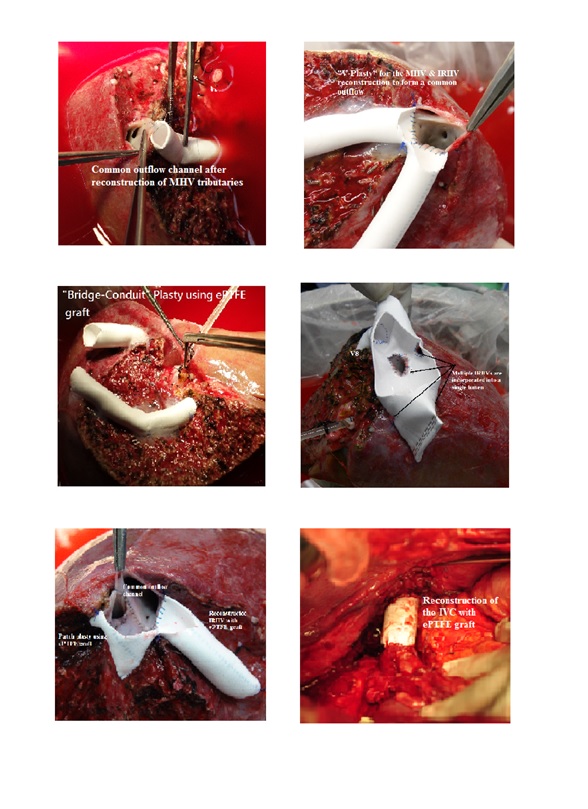Difficult Outflow Reconstruction Using Eptfe Vascular Grafts In Ldlt: Technical Innovations And Outcomes.
A. Thorat1, L. Jeng2, P. Li2, S. Hsu2, H. Yang2, C. Yeh2, T. Chen2, K. Poon2
1China Medical University Hospital, Taichung, Taiwan, 2Organ Transplantation Center, China Medical University Hospital, Taichung, Taiwan
Meeting: 2019 American Transplant Congress
Abstract number: 454
Keywords: Living-related liver donors
Session Information
Session Name: Concurrent Session: Liver: Living Donors and Partial Grafts
Session Type: Concurrent Session
Date: Tuesday, June 4, 2019
Session Time: 2:30pm-4:00pm
 Presentation Time: 2:54pm-3:06pm
Presentation Time: 2:54pm-3:06pm
Location: Room 312
*Purpose: Right liver allograft is a partial graft and hence, backtable reconstruction of undrained segments is crucial to increase the functional liver mass. Undrained segments of liver often lead to congestion after the re-perfusion of liver allograft. Such congested grafts, in absence of satisfactory venous drainage, are prone for damaging effects of the portal inflow that can delay the regenerative capacity of the liver allograft. Additionally, presence of multiple inferior right hepatic veins (IRHVs) further increases the complexity of the backtable venoplasty procedure that entails reconstruction of both, middle hepatic vein (MHV) tributaries and IRHVs. Reconstruction of such liver allografts is often challenging in absence of suitable venoplasty technique(s). In addition, type of interpositional conduit, whether cryopreserved or synthetic, is often matter of debate. However, we have recently proved safety and feasibility of expanded polytetrafluoroethylene (ePTFE) graft use in backtable venous reconstruction of such liver allografts. In this brief report, we intend to highlight the innovative backtable reconstruction techniques using ePTFE vascular conduits to overcome various venous variations of right liver allografts especially in limited retrohepatic space.
*Methods: FromSeptember 2002 to October 2018, 957 living donor liver transplantation (LDLT) were performed at China Medical University Hospital, Taiwan. The ePTFE vascular conduits were used in 563 liver allografts to reconstruct MHV tributaries, IRHVs, or both using dual ePTFE conduits. Various backtable venoplasty techniques as well as outflow reconstruction techniques were applied depending upon the venous distribution of the liver allograft, recipient retrohepatic space and graft to recipient weight ratio (GRWR) to provide an adequate and uniform venous drainage. The techniques used were “V-Plasty” technique of combined MHV and IRHV reconstruction (n=30), “Loop V-Plasty” technique (n=5), Single oval ostium technique to form common outflow (n=2), “Patch-plasty” using ePTFE graft (n=3), “bridging conduit plasty” to reconstruct IRHVs (n=53), and inferior vena cava reconstruction using ePTFE graft (n=6). The MHV reconstruction using ePTFE vascular grafts was done for 563 liver allografts. Aspirin (100 mg) was given to all the recipients from the5th postoperative day and continued for 2 years.
*Results: The 2nd month patency rates of the ePTFE grafts were 100% with no patient developing acute thrombosis or infectious complications directly related to ePTFE grafts. Primary non-function requiring re-transplantation occurred in none of the recipients. Thrombotic occlusion of the outflow resulting in Budd-Chiari syndrome occurred in 1 patient (0.38%) at 24th post-operative month. Graft migration into the second portion of the duodenum occurred in 8 patients (1.42%) that were successfully treated by surgical removal of the ePTFE vascular grafts. Among the 6 recipients that underwent IVC reconstruction using ePTFE graft, 2 patient expired at 10th and 13th postoperative month due to recurrence of the primary disease.
*Conclusions: Venous outflow reconstruction of right liver allografts with venous variations using ePTFE vascular grafts contributes significantly to the outflow of the liver allograft that not only prevents congestion of the graft, but also increases the ease of graft implantation. The ePTFE vascular grafts have wide safety margin, however, potentially fatal complications may occur that can be effectively treated if timely diagnosis is made and appropriate management is instituted. Reconstruction of IRHVs using ePTFE vascular grafts is relatively new concept in LDLT and proved to be safe alternative to multiple veno-caval anastomoses that may increase the warm ischemia time.
To cite this abstract in AMA style:
Thorat A, Jeng L, Li P, Hsu S, Yang H, Yeh C, Chen T, Poon K. Difficult Outflow Reconstruction Using Eptfe Vascular Grafts In Ldlt: Technical Innovations And Outcomes. [abstract]. Am J Transplant. 2019; 19 (suppl 3). https://atcmeetingabstracts.com/abstract/difficult-outflow-reconstruction-using-eptfe-vascular-grafts-in-ldlt-technical-innovations-and-outcomes/. Accessed January 8, 2026.« Back to 2019 American Transplant Congress

